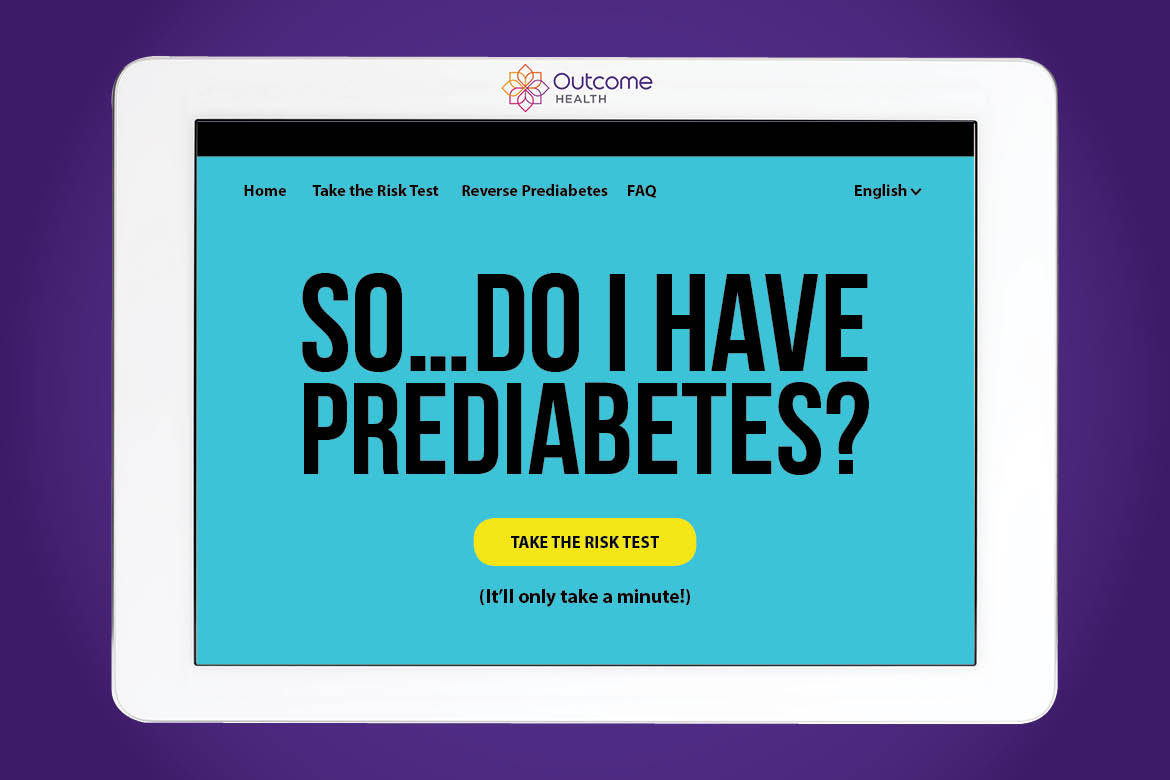To reverse prediabetes and prevent the development of type 2 diabetes, the San Bernardino Medical Group (SBMed), a multispecialty medical group in the Inland Empire area of California, has said goodbye to outdated magazines in the waiting room and hello to digital devices that help patients learn about their risk for diabetes and take preventive action.
Nurses at the practice work with patients to encourage the use of the tablet computers as they wait for a physician. Patients also see AMA educational resources displayed on a digital waiting room screen and a digital anatomy wallboard, which is used by the physician during consultation to better explain conditions.
The AMA, as part of its work to improve health outcomes, has collaborated with Outcome Health to provide devices to physician practices. These devices are designed to help patients identify their prediabetes risk, create productive conversations with providers and enable physicians to refer at-risk patients to clinically proven diabetes prevention programs (DPPs).
Patients are instructed to take the prediabetes risk assessment on the exam-room tablet computer immediately before their consultation. In doing so, Outcome Health hopes to empower patients to have a more informed dialogue with their physicians and nurses about reducing their diabetes risk.
Newly released data from the Centers for Disease Control and Prevention (CDC) show that 84 million people have prediabetes and about 90 percent don’t know they have it. Fortunately, prediabetes can be reversed through evidence-based lifestyle changes.
Empower, educate patients
About 325 patients are seen each day at San Bernardino Medical Group. Between 50 and 60 percent of patients are Spanish speaking. The practice’s patients range in age from young adults to seniors. In San Bernardino County, diabetes is a major concern. And at SBMed, helping patients achieve impactful lifestyle changes is a big challenge, according to practice administrator Vanessa Bales.
“We’re trying to really push pre-education so they don’t develop into diabetes, but diet, exercise and all of those things are really hard because they are on limited income,” she said in an interview with AMA Wire®. “Getting them geared for preventative services with diet, testing and following through with it is really important because noncompliance is a big issue with our patients.”
The nurses and physicians empower patients by educating them to become familiar with the system and what content is available on the tablets. They also have a diabetes educator who always uses an Outcome Health tablet in her educational room and will work with patients to go through the diabetes education program to work on diet and exercise, as well as other areas needed to be healthier. The diabetes educator runs through all of the programs, recipes and other steps for the DPP.
At SBMed, the biggest complaint is often the wait time. However, with the availability of digital educational prediabetes materials by way of Outcome Health’s tablets, screens and wallboards, patients are using this time in a meaningful way.
“We used to offer old magazines in the exam rooms, which were outdated and not very informative,” said Bales. “With modern technology, we’ve eliminated the magazines and encourage patients to utilize the tablets. Patients love all the information available because they have different areas for them to access.”
Even senior patients are becoming more comfortable with their phones or even have their own tablets. While patients over the age of 80 are less receptive to the use of the tablets, most patients below this age love using the new technology, Bales added.
“It is much more interesting because we are tapping into technology that is already kind of on the forefront and by doing that, it is already captivating their interest,” said Bales. “We explain what is on the tablets and our patients like it. So it tends to be tapping into a need that we have now.”
Patients struggle to act on results
To keep patients from developing diabetes, the San Bernardino Medical Group motivates their nursing staff through measurement standards that need to be met. Nurses regularly make sure patients are up-to-date by providing prediabetes information. And if the patient has abnormal laboratory values, the physicians are checking each patient at their next visit to ensure they get the follow-up care they need, which is where a lot of the tablets are used.
However, once patients have taken the risk assessment and are evaluated by the physician, participation in the DPP remains a hurdle. Once patients are identified, physicians and nurses work to transition them into the education program. While SBMed’s patients are receptive to the new technology, physicians and nurses at SBMed have encountered some resistance among patients when it comes to enrolling in a DPP.
“A lot of patients are in denial and don’t really want to admit they have a problem, or they just don’t want to change,” said Bales. “We are constantly going over things to make sure our patients have all the necessary information. It’s supporting our efforts to educate our patients. Getting them to comply is the biggest frustration. You can provide the information, but you can’t make them do it.”
The staff at San Bernardino Medical Group continually emphasizes the importance of the DPP to reverse prediabetes and prevent type 2 diabetes among their patients. The diabetic education nurse also monitors patients, while several other team members check the numbers and follow through with the patients they are concerned about.
As the program moves forward, the San Bernardino Medical Group will work to improve patients’ transition into the DPP. Recently, the AMA, CDC and the Ad Council launched a public service announcement ad campaign to urge Americans to take the one-minute prediabetes risk test. The campaign highlights the importance of following up with a physician to learn more about prediabetes.
The AMA offers online CME to expand your knowledge in diabetes management. Explore educational content such as “Prevent Diabetes STAT.”
Editor's note: The AMA's pilot with Outcome Health ended in October 2017.




